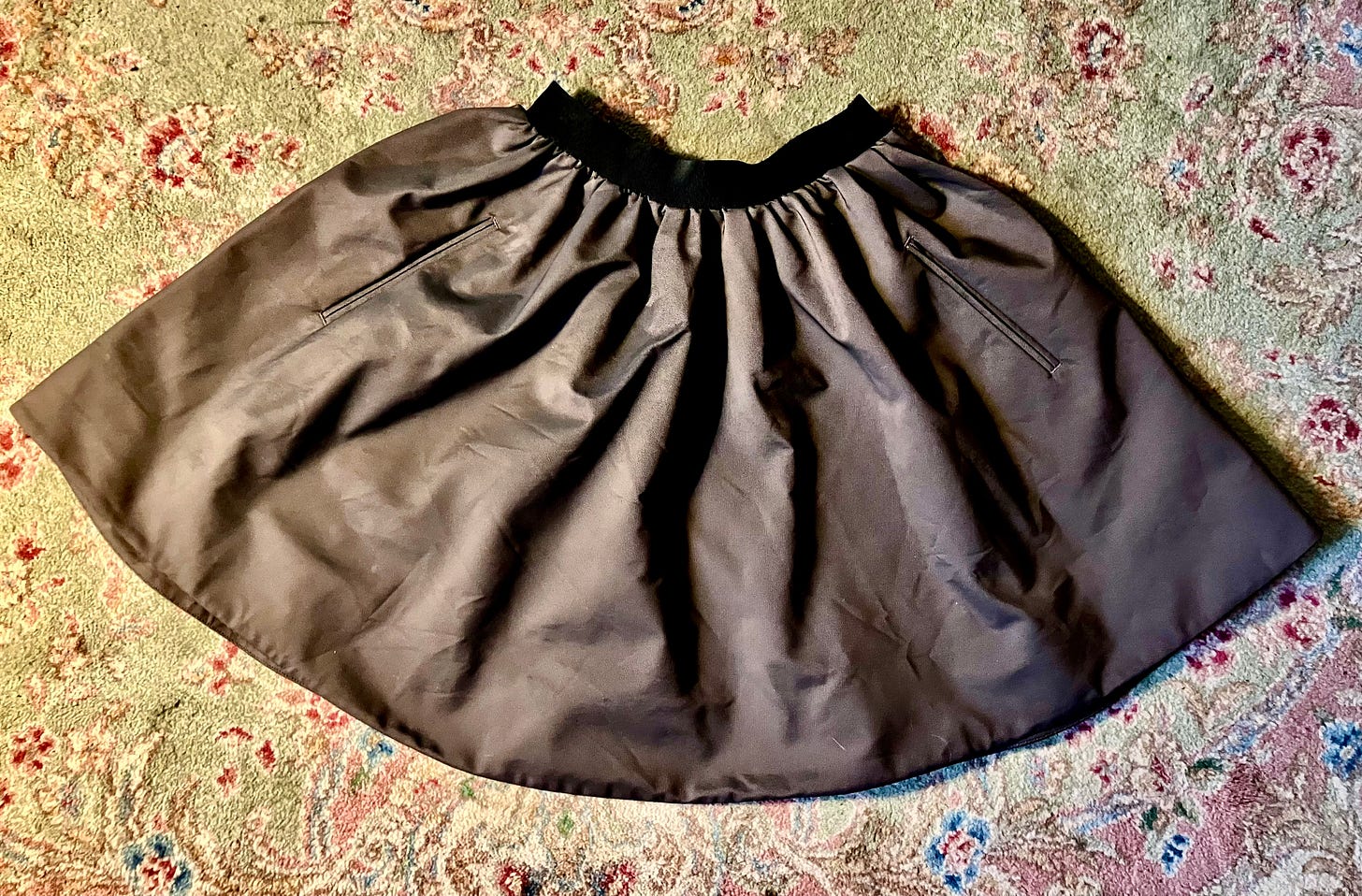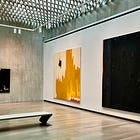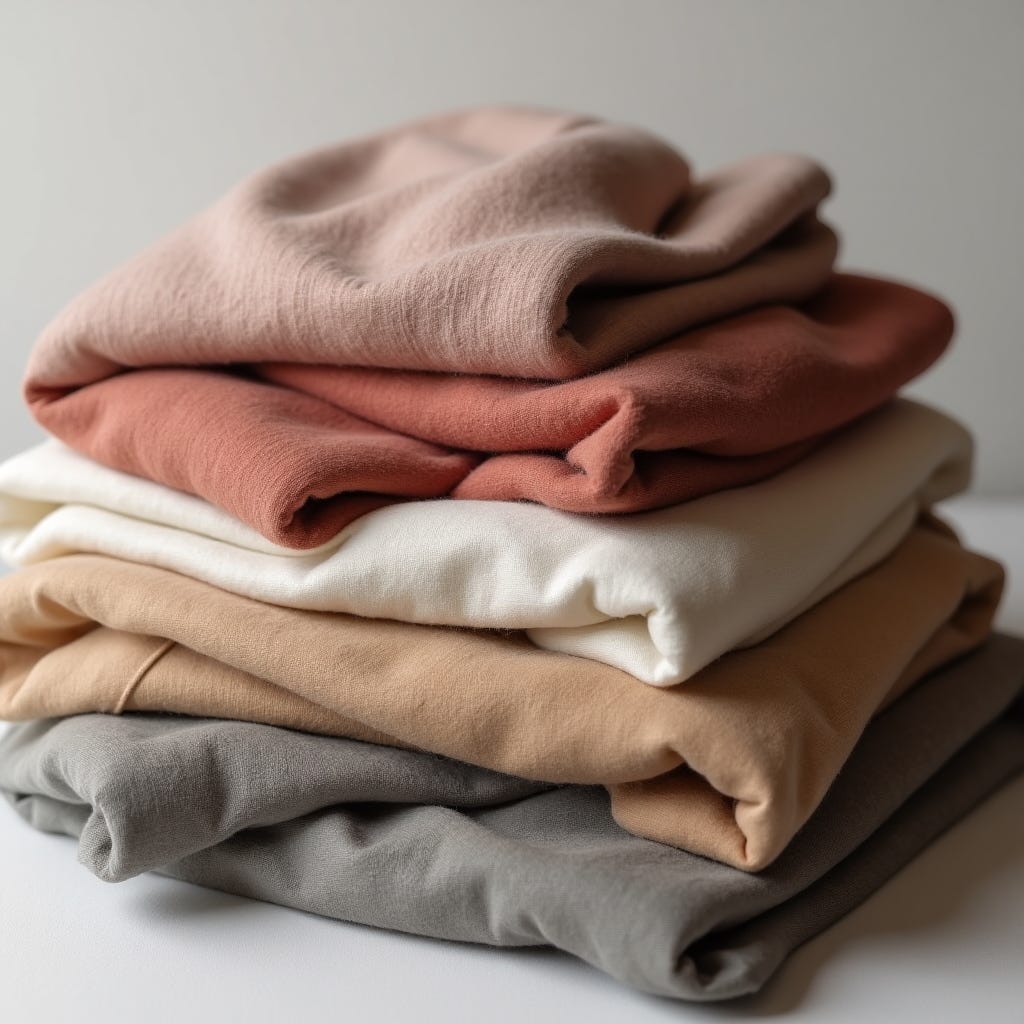The Artist's Hack for Scoring Upscale Clothing at Thrift Stores
The Art of Frugal Hedonism, Part 3

Hello, dear readers. Welcome back to the Hard Truths for Poor Artists spin-off series, The Art of Frugal Hedonism. I’m sharing artists’ mindsets, strategies, and tricks for spending as little as possible without sacrificing pleasure, inspiration, or beauty.
You can find earlier posts in the series here:
Musicians, painters, and writers often find ourselves in public-facing situations where we need to shine. Most of that is a matter of talent and personality, but some of it is sartorial. Events like openings, readings, concerts, or lectures require us to appear polished with some flair, attired to take the stage and hold the floor. Without generous clothing budgets, some working artists rely on secondhand shopping tricks to build wardrobes of event-worthy quality pieces.
Following is the greatest thrift store clothes shopping hack I know, and how I came to know it. This trick will make every thrift store your happy hunting ground for used fashion. Because if we’re honest, we all want to look nice. At least sometimes.
The first time I went thrifting with a prep school artist kid was in my freshman year of college, in 1991. One winter afternoon, I was returning to my University of Kansas arts dorm after morning classes when I noticed an older Mercedes parked creatively, at an extreme angle to the curb. Behind the wheel was Jay’s Roman profile and asymmetrical haircut.
“Come thrifting with me, Michelle!” Jay called from his open car window, tossing a still-burning cigarette onto the street. “Let’s find you something to wear besides that mirrored neo-hippie skirt.” One of Jay’s cooler arts dorm friends had just bailed on him, I guessed.
“I have to go to work in a couple hours,” I said.
“I’ll drop you at work after we thrift,” Jay assured me.
In the vintage Mercedes, a hand-me-down car from Jay’s grandmother, I selected the Talking Heads’ Stop Making Sense from his zippered black case of cassettes. It was the best option by far in Jay’s awful music collection.
“David Byrne, good,” he said, nodding his head to the music. “That chaos jazz you always play in your dorm room isn’t helping your social life, by the way.”
I found Jay’s strong opinions on music, sex, and drugs both amusing and easy to disregard.
When we arrived at the crammed thrift store, however, Jay’s tough love expertise was exactly what I needed. He scowled at my first find, a poly-blend peasant blouse.
“Ew,” he said. “Why would you pick out that mess?!”
“I like the print,” I said.
“Put it back!” Jay commanded. “You really are fresh off the farm.” I truly was.
While I was finding this single objectionable blouse, Jay had gathered a whole armful of promising clothes for himself. His try-on pile had an exotic sumptuousness I couldn’t yet place. Jay’s wardrobe was unlike the middlebrow brand preppiness of frat boys or the aggressive gothiness of arts dorm boys who all seemed to be modeling themselves after The Cure’s Robert Smith just then.
“I’ll go through the women’s section with you,” Jay said. “It’s simple.”
I’d only know Jay for a few more months. He’d soon leave KU to study architecture at Brooklyn’s Pratt Institute, where, he predicted, “a queer like me will flourish.” He probably did. It would be six years before I’d move to New York to flourish myself and come to know anything at all about fashion, which, even now, isn’t a whole lot.
But the thrift store hack Jay taught me that day bypasses fashion sense. Over the years, Jay’s trick has helped me thrift everything from a $4.99 Hermes silk scarf that I resold online for $200 to a $12.99 Worth New York trench that I keep for those occasions when I can use a $600 coat to look instantly put together. If an 18-year-old farmgirl like me could learn Jay’s trick, anyone can.

Jay’s trick: A visual scan for high-quality fabrics
“Fabrics!” Jay said in the Kansas thrift store that afternoon. He used a self-important businessman’s tone I’d later recognize as a parody of the “Plastics!” tip for young Dustin Hoffman in The Graduate.
“You scan the racks for natural or high-quality fabrics like cashmere and silk,” Jay explained. “Merino wool and linen. Some fabric blends are decent, too. Okay, look at the sweaters. I want you to point out the nicer ones.”
“I don’t know,” I said. “The light green one?”
“That’s obviously acrylic!” Jay yelled. “Not natural. Synthetic.”
Spotting high-quality fabric was second nature for Jay because he’d been raised among people who wore finer clothes. I told Jay to put himself in the position of someone who hadn’t. My position.
Here’s what Jay came up with that afternoon:
Look for depth and texture. This time we scanned a rack of women’s blazers, with an eye toward a visible weave, little nap, or a certain luster. Just like that, I spotted a bright pink Chanel blazer on the rack for $19.99. Jay said its fabric was “bouclé.”
“I don’t want that jacket, though,” I told Jay.
“Of course you don’t,” he said. “You’re a college student, not a middle-aged lady who lunches. This tip will help you find a cool suede jacket you do want. But I’m buying the Chanel. My aunt would kill for it. I’ll be her hero.”
Look at how clothes hang. Cheaper fabrics, Jay explained, tend to stand at attention or cling to a hanger. Nicer fabrics drape more naturally. This is how I later spotted the aforementioned Hermes silk scarf amid stiffer polyester ones.
Look for colors that are hard to name. More unusual hues can indicate higher fabric quality. Jay showed me the difference between a poly blend dress in basic red and a nearby merino wool one in a color we could only identify as “maybe burgundy at dusk.”
Fabric texture, drape, and color all contributed to the impression of sumptuousness in Jay’s armful of thrift store clothing. His look, which I could now name, was creatively styled luxury.
How thrift store fabric scanning plays out in real adult life
A few years ago, I was invited to Siena, Italy as the first woman lecturer at a summer jazz institute and festival. Presentability was required. Previous visits to the country had shown me that Italians, especially of the culturati class, dress at night.
On a morning walk home from the library here in Colorado, I popped into Goodwill and scanned the clothing. Among the jacket rack’s vinyl and polyester, a sleeve in a rich white cotton blend leaped out at me.
It was a new Norma Kamali blazer for $9.99. I tried it on. The blazer instantly elevated my walking-to-the-library sundress into a Euro dinnertime ensemble. I googled it. The blazer retailed for $325 at the time.
Upon arrival in Siena, I had this white blazer pressed at my hotel, along with a couple of other linen wardrobe essentials. I wore it to my lecture and also to dinner and a concert or two over sundresses. Thrift store fabric scanning yielded an elegant fashion solution for next to nothing.
Why a visual scan is better than the touch test or checking tags
Some thrifting friends swear by the “touch test,” walking along a rack or bin of clothes and feeling each item for quality. Natural fabrics have a distinctive feel on the skin. People with tactile orientations love to put their hands all over nice things, anyway.
The touch test is effective, but way too time-consuming for me in a thrift store. As is checking the label on every piece of clothing. Only after I’ve done a quick visual scan for quality fabric do I move in to touch an item of clothing or read a label to confirm its fabric content and see if it’s a brand I recognize.
Besides, a visual fabric scan can turn up high-quality overseas brands I’d never recognize from a tag check. Some of my son’s toddler wardrobe, for example, came from scanning thrift stores for good fabric and then, with googling, discovering the adorable little sweater or overalls I’d found were from a designer Scandinavian brand.
N.B. It’s important to scan for all quality fabrics. If in the winter we only look for alpaca or cashmere in a rack of sweaters, we may miss a choice sea island cotton sweater for summer. If we make a habit of scanning for all finer fabrics, we find more great stuff.

Good shoes and handbags are relatively easy to find
Thrift store bag racks and shoe shelves are relatively easy to scan for quality leather. Once, and only once, I spotted a Prada handbag for $14.99 in a thrift store. I resold that mother immediately for $525, covering my family’s pool dues for the summer.
In a New Jersey store, a mere glance at the shelves revealed a pair of new green cowboy boots for $18. They stood out for their buttery leather as much as their color. No branding anywhere on them. I wore them to readings and panel discussions for years. Once, I was walking on a Detroit sidewalk when a woman screeched her Lexus to a halt on the street beside me and yelled, “I want those boots, girl!” These boots were made for walking and talking in public.
See how the fabric scan works for you
I don’t always get it right in thrift stores. Plenty of times, I assume a piece of clothing is high quality from afar only to discover it’s not upon further inspection. Also, I no doubt miss luxury pieces in my quick visual scans of the secondhand racks. And friends with prep school backgrounds still outshop me in every thrift store we visit together.
Still, I do often find sumptuous clothing using Jay’s trick, and have passed his hack on to others who report similar success. Let me know how it works out for you—or by all means, share other tricks for finding upscale clothing in secondhand stores.
See you next week with an artist interview.









Take this post down, please — and go sell it to Teen Vogue or something
This was a revelation. Because for some reason, I've always been able to walk the length of a jam-packed sale rack and spot the one or two good pieces crammed in with the schlock. I've never known why, but now I figure maybe I have an eye for fabric. Who knew?